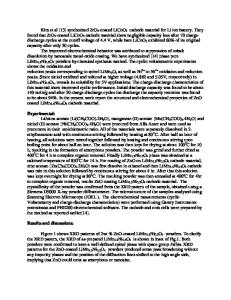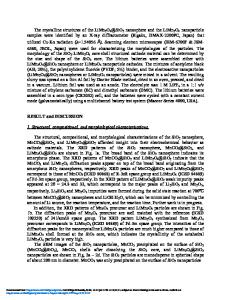The use of Nano- Synthesis Methodology on Electrochemical Performance of limn 2 o 4 Cathode at elevated Temperature
- PDF / 1,731,211 Bytes
- 14 Pages / 432 x 648 pts Page_size
- 26 Downloads / 320 Views
MRS Advances © 2018 Materials Research Society DOI: 10.1557/adv.2018.297
The use of Nano- Synthesis Methodology on Electrochemical Performance of limn2o4 Cathode at elevated Temperature Mudono S1,Tshuma J1, Manhongo T.T1, Madzokere T.C 2, Tsorai P2, Witika L.K3
1
Department of Chemical Engineering, Faculty of Industrial Technology, National University of
Science & Technology, Bulawayo, Zimbabwe
2
Department of Chemical and Process Systems Engineering, Faculty of Engineering and Technology,
Harare Institute of Technology, P. O. Box BE 277, Belvedere, Harare, Zimbabwe
3
Department of Metallurgy, School of Mines, University of Zambia, Lusaka, Zambia
ABSTRACT:
The effects of different starting materials using nano-synthesis methodology on electrochemical performance of lithium manganese oxide (LixMn2O4) are studied. Four spinel-type LixMn2O4 (LMO) cathode materials were prepared with different lithium and manganese sources and were analyzed chemically and characterized by BET and XRD. The electrochemical performance of the cathodes at room temperature and elevated temperature was tested. The crystal structure was indexed to be a cubic system with lattice parameters of 8.2342 ±0.170 Å and defined to the space group Fd3m. There was no peak of impurity because the raw materials for Mn source were first treated with acid. Although the results showed that the structures of the samples were confirmed to be cubic spinel structure, the lattice parameter and specific surface area of the samples were different. The LiMn 2O4 cathodes have an initial discharge capacity of over 120mAh/g and show an ordinary two-step voltage profile. The results demonstrated that the cathode materials prepared with LiNO 3 as Li source have larger lattice parameters, than those prepared from LiOH·H 2O as Li source. The cathode prepared from Electrochemical Manganese Dioxide (EMD) as Mn source have larger particle sizes, lower first charge and discharge capacity, better cyclic performance,
Downloaded from https://www.cambridge.org/core. Access paid by the UCSB Libraries, on 22 Mar 2018 at 10:09:39, subject to the Cambridge Core terms of use, available at https://www.cambridge.org/core/terms. https://doi.org/10.1557/adv.2018.297
whereas those from Chemical Manganese Dioxide (CMD) as Mn source have smaller particle size, higher first charge and discharge capacity, and poor cyclic stability at elevated temperature. The cell polarization of the cathode developed by LiOH•H 2O and EMD was identified to be the least and the elevated temperature cycelability to be the best. These manifestations can be attributed to differences in Li and Mn sources, specific surface areas, purities of starting materials and synthesis conditions. Melt-impregnation as a nano-synthesis method proved to be an excellent method to synthesize LiMn 2O4 cathode materials that can operate at elevated temperatures when using correct starting materials and good control of synthesis temperatures. Corresponding Author: Stanford Mudono, [email protected]
INTRODUCTION
Data Loading...











